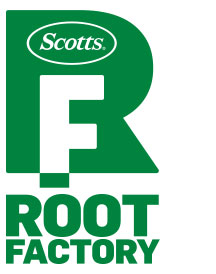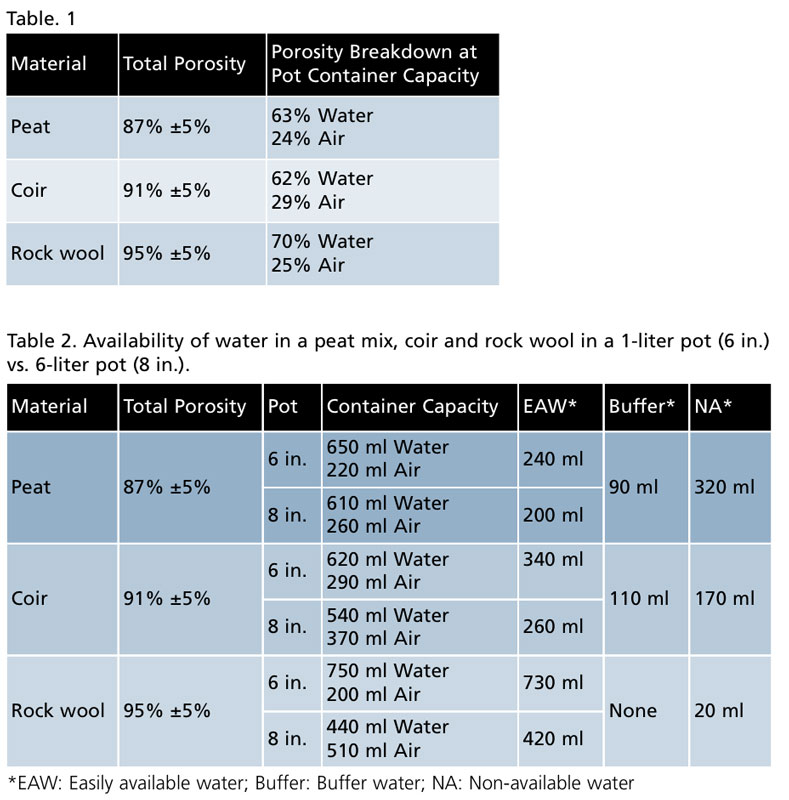10/1/2019
Peat, Coir or Rock Wool?
Jean-Pierre Fortin, Dr. Reza Nemati & Rick Vetanovetz

The selection of a growing medium is a perennial and recurring topic. Growers know that a good mix needs to hold water and release it gradually to the crop, and also allow air infiltration critical for healthy roots. But assuming that those items are provided, what growers really want to know is, “Will it dry out fast enough or too quickly or hold too much water?” All valid points.
To be sure, these points will be dictated not only by the mix, but the crop and crop age, the container size and the environment. But what type of information do you need to know to make a choice that’s right for your crop, container configuration and growing style? This article is intended to help explain how you can “dial-in” and make better choices.
Let’s get our hands dirty ...
Various components commonly used today as a growing medium include sphagnum peat moss, coconut coir pith, composted bark, perlite, pumice and even rock wool. All of these materials have physical characteristics by themselves that demonstrate a certain way they hold water and air. Then when you mix these materials in whatever recipe you choose, that mixture will demonstrate a unique way it holds water and air. But how does a mix “release” water to the plant? And how fast, or slow, does it do that?
To illustrate this, let’s use and compare sphagnum peat moss, coconut coir pith and rock wool. As mentioned, water and aeration properties of a growing media heavily depend on its texture and structure where used. Peat and coir have internal porosity that absorbs and retains water. Rock wool fibers have no internal porosity, thus the water is mainly retained by adsorption to the inert structure of the rock wool through adhesive forces.
In peat and coir, both phenomena participate in water retention: absorption into peat and coir fiber, and adhesive forces of water molecule over internal surfaces and between water molecules themselves. These two factors influence the nature of the growing media.
The typical way one may choose a growing media is to compare key physical properties. Properties such as total porosity, water-filled porosity (pore space), or “container capacity” and air-filled pore space. Total porosity is the total internal volume of “space” of a media. Most growing media do not differ much in that matter. Total porosity does provide insight into how the growing media will perform when in use.
The structure and texture of the growing medium components will dictate how water is retained and released. The breakdown of total porosity will reveal more information on the behavior of a particular mix. Although air-filled porosity is relatively the same, water-filled porosity is fairly higher for rock wool.
That can be broken down further, revealing more information on the influence of a growing media structure on the behavior of the water retained in the porous nature of the three types of growing media.
The water reservoir contained in a pot can be described by the ability of plant roots to absorb that water. In other words, water isn’t always readily accessible to plants. A strength must be deployed that’s at least equal and exceeds the forces that make water molecules retained in the mix through adsorption and absorption. Other factors, such as dissolved solutes (salts) and temperature also influence water absorption by roots, but let’s consider only the influence of the mix structure.
Let’s drill this down further ...
Water availability can be categorized in three major categories: Easily available water, buffer water and non-available water. These phases are defined according to the strength that must be exerted on water for the plant to take the water up. The force that’s needed can be quantified and is measured in units of negative pressure or “positive vacuum.” Soil scientists use units of measure called Pascals (Pa) denoted as kPa.
The strength exerted on water molecules is greater as the growing medium dries. Thus, a greater amount of work must be deployed by plant roots to access water at a lower media moisture.
For ease of comparison, we’ll demonstrate the properties in a standard 6-in. and 8-in. pot. We’ll note that the water phases are different for the three mixes. All three media have ample air/oxygen to maintain root functions and metabolism. However, most of the water is available in rock wool. That’s because rock wool fibers themselves don’t absorb water, but they retain water via the loose configuration of those fibers over each other to form “pores.” But rock wool has no buffer water and the transition from wet to dry is dramatic.
The peat and coir mixes demonstrate a portion of the water in the buffer form and under a tighter form that’s the non-available phase. Although water availability is less in peat and coir, the transition from easy-to-absorb water toward dryness is more gradual. This means that plants will have more time to adapt as the growing medium dries, gradually closing the stomata, and slowing down metabolism and growth in peat and coir compared with rock wool. It doesn’t mean that one substrate is better than the other, but that the growing conditions are different and it requires different irrigation strategies.
 Peat and coir have their own buffer created because of the spongy nature of the fiber and the arrangement of the fiber between each other. This gives the grower a small amount of time before plants show visual signs of wilting. However, with rock wool, there’s no buffer, so a buffer zone (safe zone) must be artificially created in maintaining a minimum water content away from non-available water level. This will depend on a few factors, such as the volume of the rock wool module, and the type and size of the plant. Rock wool suppliers and irrigation suppliers recommend various strategies to avoid wilting of a crop. It typically consists of a certain set of water volume applied at increasing events as the plant grows.
Peat and coir have their own buffer created because of the spongy nature of the fiber and the arrangement of the fiber between each other. This gives the grower a small amount of time before plants show visual signs of wilting. However, with rock wool, there’s no buffer, so a buffer zone (safe zone) must be artificially created in maintaining a minimum water content away from non-available water level. This will depend on a few factors, such as the volume of the rock wool module, and the type and size of the plant. Rock wool suppliers and irrigation suppliers recommend various strategies to avoid wilting of a crop. It typically consists of a certain set of water volume applied at increasing events as the plant grows.
Note that with peat and coir, reaching non-available water doesn’t mean that plants will readily wilt; it means that the water in that phase is much more difficult to get and water will be more slowly absorbed. Significant wilting may occur at approximately -25 to -30 kPa, depending on mix. The speed at which wilting occurs depends on plant size (water need), temperature (hot vs. cloudy day) and water reservoir (small vs. large pots).
Container size has a significant impact on how a growing medium supplies air and water. Table 2 shows how air and water content changes with container size. Doubling container height, for example, allows gravitational forces to force more water out of the bottom of the container. In other words, there are more pores filled with air in larger pots leaving less water pockets, assuming the volume is the same. Considering that factor, one may change strategy when selecting a substrate. Highly porous media may be less suited for taller containers, so the growing medium may be easy to manage when plants are small, but when the plants become established, frequent watering may be necessary.
This is important and often overlooked. Smaller pots hold proportionally more water, but have a smaller amount of water available. Such crops require a large volume of water, but larger containers hold less water proportionally to pot size. The drying behavior of the substrate must be considered in establishing the irrigation strategy.
The media and pot size will dictate how much volume of water should be used at each irrigation and the timing and frequency is dictated by the crop and conditions. For optimum watering, the volume of water to use should be as close as possible to easily available water: 250ml ±50ml, 350 ml ±50ml or 650 ml ±50ml per irrigation for peat, coir and rock wool in a 6-in. pot (Table 2). The crop and weather conditions will dictate the watering frequency.
Actually, the volume per irrigation should be always the same since they’re determined by the characteristics of the substrate and pot size. The frequency of watering will vary as the crop grows up following environmental conditions since plants will absorb water quicker as temperatures get warmer. At the finish line, it means that the characteristics of the mix and the influence of the container must be known to establish an optimal irrigation strategy.
Take-home messages
How do we irrigate for optimal growth? We used terms like “strength,” “forces,” “kPa” and “works” in this article—the reason is because roots have to battle with those forces to absorb water. Plant roots have to “work” to capture water and minerals. Work requires energy. In other words, plants have to expend energy to absorb water and nutrients.
So what does that mean to you? From the standpoint of the growing media, it means knowing the portion of the water that’s easily available, and regulate irrigation and nutrition as a function of it. Using long wet/dry cycles and drying out the medium into the non-available zone will slow down plant metabolism and growth. Irrigating within the easily available range makes the plant spend less energy to absorb water and minerals and put more energy in plant growth. GT
Jean-Pierre Fortin is Manager of Professional Technical Services, Dr. Reza Nemati is Research Principal and Rick Vetanovetz is Director, NA Professional Technical Services, of Scotts Canada.